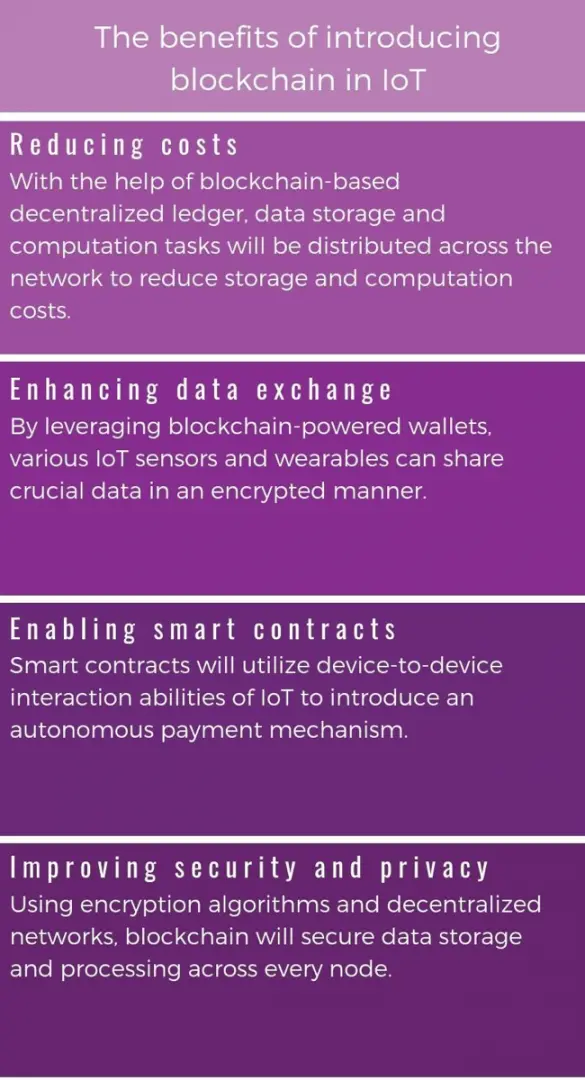As the IoT infrastructure keeps growing exponentially, security issues will become more common.
Therefore, there is a dire necessity for high-end security solutions. Will the introduction of blockchain in IoT be able to solve this crisis?
Since the dawn of connected devices, IoT has shown immense potential in several industry sectors, such as retail, manufacturing, and agriculture. The advancements in IoT have also presented smart cities with numerous applications like traffic management and smart parking lots. Due to the increasing buzz surrounding IoT and a wide range of potential applications, 23.14 billion connected devices were installed globally in 2018 and 26.66 billion devices were installed in 2019, and is projected to amount to 30.9 billion units by 2025.
Despite rigorous research and aggressive adoption, IoT infrastructure faces major security issues. Hence, several researchers and developers are exploring enhanced security protocols provided by blockchain. Blockchain has already introduced a secure platform for cryptocurrency transactions. Similarly, the utilization of blockchain in IoT will lead to the development of distributed ledger for interfacing multiple connected IoT devices. With such an approach, data storage and networking of IoT-powered devices will be drastically improved.
EXISTING PROBLEMS WITH THE CENTRALIZED SYSTEM
In the mainstream applications of IoT, various IoT devices and systems interact via a centralized system. Just like any centralized network, IoT infrastructure is vulnerable to different forms of cyber attacks such as malware, DoS attacks, Man-In-The-Middle attacks, and brute-force attacks. Also, many IoT devices and software are riddled with bugs and security loopholes. Hackers can exploit these loopholes to execute high profile cyber attacks. For example, attackers of the popular Rube-Goldberg attack exploited an IoT bug called Devil’s Ivy to gain access to vulnerable cameras. Using the exploit, attackers can factory reset connected cameras and obtain root access privileges. With root access, attackers can easily view the live feed from the camera.
Attackers can also access multiple connected devices by gaining access to the network. For instance, a university had witnessed over 5,000 IoT devices attacked. The published report also included that the campus IT staff discovered that more than 5,000 discrete systems were frequently making hundreds of DNS lookups in the interval of 15 minutes, slowing down the entire network. Upon further inspection, the IT staff found that hackers were attempting a brute-force attack to breach through IoT devices with weak passwords. In a similar fashion, hackers can access multiple connected devices to steal crucial data affecting the privacy of several users. Another major challenge for IoT infrastructure is high computation and storage costs necessary for scaling up IoT solutions. The cost of installing and maintaining huge server farms, centralized cloud, and networking equipment will only prove to be increasingly expensive as the infrastructure keeps growing. Even after installing necessary equipment and devices, every node of the IoT infrastructure can face latency issues and disrupt the whole network in case of a failure.
4 BENEFITS OF BLOCKCHAIN TO IMPROVE THE INTERNET OF THINGS
The introduction of blockchain in IoT will benefit IoT infrastructure in the following ways:
1. Reducing Costs
Blockchain-based networks will create a decentralized peer-to-peer connection among IoT devices. Compared to a centralized system, blockchain in IoT will help process more data requests using various end-points. With this approach, data storage and computation tasks will be distributed across the blockchain-based network. Hence, organizations can reduce storage and computation costs that are usually incurred while running a centralized system.
2. Enhancing Data Exchange
IoT devices constantly exchange data with other devices and systems. But, exchanging data between various devices and systems can be complicated due to security issues and high network latency. However, with blockchain in IoT, collected data can be shared using secure blockchain wallets. By leveraging blockchain-powered wallets, various IoT sensors and wearables can share crucial data in an encrypted manner. Also, the data stored in blockchain wallets can be accessed only by authorized devices and systems.
3. Enabling Smart Contracts
Blockchain-powered smart contracts have several applications in supply chain management that enable the automation of transactions after predefined terms are met. Likewise, blockchain in IoT will take advantage of the device-to-device interaction capabilities of IoT to introduce an autonomous payment mechanism. For example, vehicle owners can benefit from automated fuel purchases by installing special IoT sensors that interact with IoT devices in fuel pumps. IoT devices at gas stations will verify vehicle and driver information stored in IoT sensors in the vehicles and automatically receive precise payments.
Blockchain-based smart contracts will also benefit autonomous cars. Autonomous cars can exchange crucial information such as traffic information, accident reports, and proximity to other cars. With this approach, autonomous car manufacturers can obtain more data and improve on-road decision-making. Along with these benefits, blockchain in IoT will enhance security protocols of the IoT ecosystem. Blockchain will deliver public and private decentralized networks for secure data storage and data exchange.
4. Improving Security and Privacy
The increasing adoption of IoT devices poses the critical issue of securing smart devices on a large scale. However, with blockchain in IoT, the decentralized networks will ensure encryption of data across the network. In case a cybercriminal gains access or alters contents of a file, then the digital signature of that file will not match with the original signature generated during encryption. Using this mechanism, the integrity of data can be verified. Also, blockchain networks can incorporate consensus models for detecting malicious activity in the network and mitigating any identified threat. Furthermore, since data and computation tasks will be distributed on a blockchain across several nodes, the network will continue to function efficiently even after any node fails.
With blockchain in IoT, every IoT device can be registered with a unique blockchain-based ID to help in the identification of each device. To establish a machine-to-machine connection, the local blockchain wallet can send a digitally signed request to the target device. Then, the target device will verify the signature using the public key of the sender. With such an approach, machine-to-machine authentication will be possible without requiring any centralized authorization mechanism.
For maintenance purposes, developers can push software updates, secured with cryptographic hash, as URLs on the blockchain networks. To authenticate software updates, IoT devices can validate the cryptographic hash of update files. Also, blockchain in IoT will enable the system to record the metadata for generating an immutable history of various IoT processing tasks, maintenance operations, and software updates to ensure regulatory compliance. Such records can be shared with key players in the organization as proof of all legal and regulatory compliance. Blockchain networks can be public as well as private. Organizations can create private blockchain networks that only business leaders and employees can use. Such blockchain networks can incorporate authentication mechanisms to control data access. For this purpose, organizations can deploy blockchain-based smart contracts. Business leaders can define terms for verification of employee details in smart contracts to automate the authentication process.
Although blockchain in IoT will make the IoT ecosystem more secure, blockchain is not a silver bullet to save IoT. The introduction of blockchain will bring with it multiple limitations such as scalability issues, high processing power and time requirements for encryption algorithms, increasing storage necessities, and latency issues. These shortcomings can get even worse as the IoT network keeps growing. Hence, developers need to fix such limitations before the mainstream adoption of blockchain in IoT. Alternatively, organizations can deploy edge computing solutions to avoid blockchain-related issues altogether. With edge computing, all IoT data will be stored at the nodes to reduce latency and secure data at the device itself. With this approach, cloud and device interaction will only be used in necessary scenarios and the overall speed of IoT data processing will be improved.




Leave your comments
Post comment as a guest